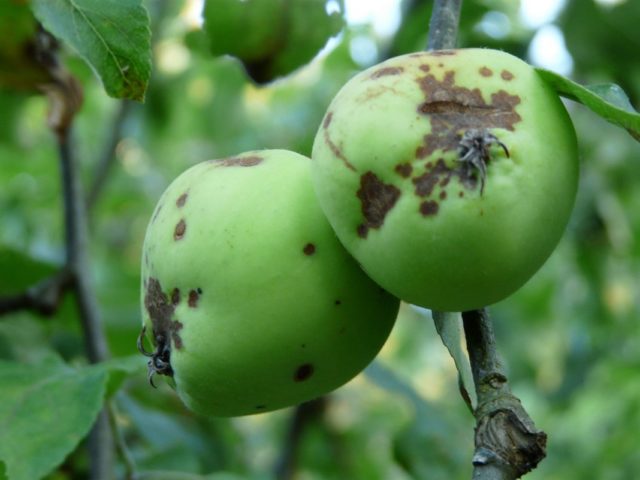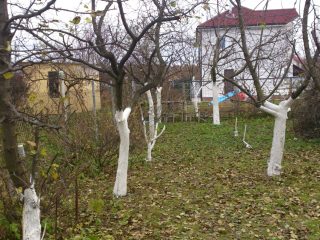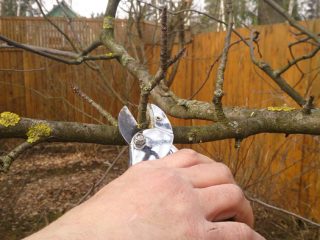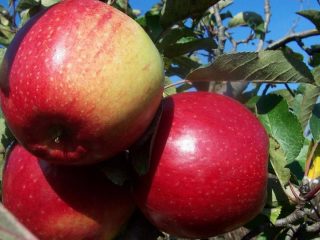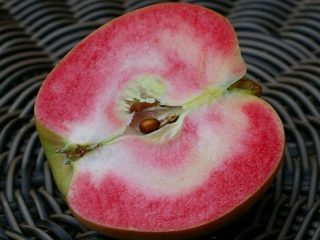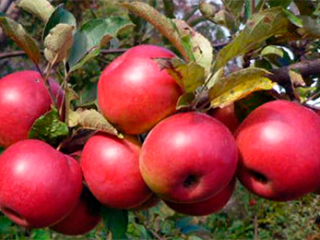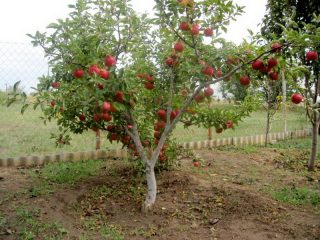Content
The Mutsu apple tree variety appeared in the middle of the last century in Japan and soon became popular in many countries of the world, including in the former CIS republics. Taking into account the relatively simple rules of care, not only a professional gardener, but also an amateur can grow a crop and reap a rich harvest.
History of selection
The Mutsu apple variety, which has another name Crispin, was created by crossing the Golden Delisios variety with the Indo-Japanese variety. This happened in 1948 in the Japanese province of Mutsu. This is where the name of the variety comes from.
Description
The Mutsu apple tree has an external resemblance to other representatives of this culture. However, some details indicate that it belongs to this variety.
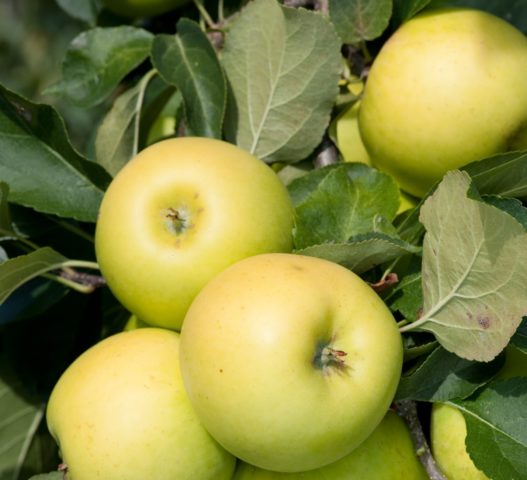
The Mutsu apple tree looks similar to its relatives
Appearance of fruit and tree
The Mutsu apple tree is a medium-sized tree, the height of which varies from 2.5 m (dwarf rootstock) to 4 m (seed).The crown at a young age is rounded, as the tree matures it becomes spreading pyramidal or reverse pyramidal. Strong skeletal branches extend upward from the trunk at an acute angle. The lower branches may be drooping under the weight of the fruit.
The ability to form young shoots is average, so the crown of the Mutsu apple tree is not particularly thick. The foliage is also medium, which provides the fruits with free access to sunlight. The Mutsu apple tree does not have roots.
The leaves are large, elongated, dark green, and have pubescence on the inside. In mature trees, they twist slightly clockwise.
The flowers are medium-sized, milky white, saucer-shaped. The ovary is formed on fruit twigs and ringlets.
The fruits are round-conical, with barely noticeable ribbing, slightly sloping at the bottom. The Mutsu apple variety, as can be seen from the photo and description, has a yellow-green color with a one-sided pink blush. The average fruit weight is about 150 g.
The growth rate is affected by the age of the tree. Until 7 years old, the Mutsu apple tree grows actively, after which the annual growth decreases noticeably.
Lifespan
Each organism has its own life span. The Mutsu apple tree, which retains its viability for 15-20 years, is no exception. It is characteristic that the yield of the tree does not decrease over the years.
Taste
The skin of ripe fruits is smooth, shiny, dense. The pulp is juicy, medium-grained. The taste is pleasant, sweet and sour, with notes of honey. The overall tasting rating of Mutsu apples is 4.5-5.0 points.
Where are Mutsu apples grown?
The Mutsu variety is cultivated in many areas.The apple tree does well in the countries of the former CIS and in almost all regions of Russia characterized by a temperate and warm climate.
In the southern regions the tree grows more actively than in cooler regions. Affects growth rate and weather. In the warm sunny season, there is a higher annual increase than in the rainy and cloudy season.
Productivity
The Mutsu apple variety receives good reviews from gardeners due to its high yield. With proper care, you can get about 30 kg of apples from one mature tree (5-7 years old), 60-65 from a 12-year-old tree, and about 150 kg from an apple tree that is already 15 years old.
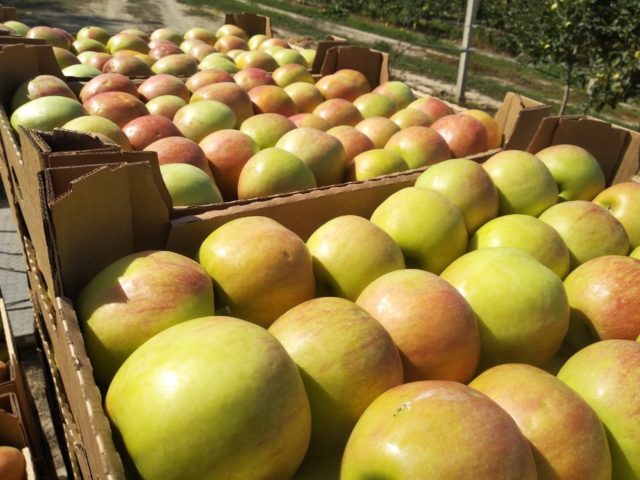
One tree can produce up to 150 kg of apples
Frost resistance
The Mutsu apple tree is characterized by average frost resistance. A decrease in temperature to -35 °C can be destructive for trees of this variety, so in regions with a cold climate, seedlings need shelter.
Resistance to diseases and pests
The Mutsu apple tree is resistant to fungal diseases. However, there is a possibility of problems such as:
- Scab. The cause of the disease is high humidity. A characteristic symptom is spotting of fruits and leaves. Scab is treated with fungicides, infected leaves are burned in the fall, and the soil around the tree is dug up.
Sign of scab - spots on fruits and leaves
- Powdery mildew. The disease can be identified by the appearance of a white coating on the leaves. To prevent and treat the disease, use a 1% solution of Bordeaux mixture.
White coating on the leaves indicates the appearance of powdery mildew.
Pests also plague the apple tree. The main one is the codling moth. For prevention, insecticidal preparations are used.

The codling moth feeds on apple pulp
Flowering period and ripening period
The flowering period of the Mutsu apple tree begins in mid-May, when the likelihood of spring frosts is significantly reduced.
Fruit ripening time varies from late September to early November. It depends on climatic conditions.
The Mutsu apple tree is fast-bearing. On a dwarf rootstock, it produces the first fruits already in the second year after planting, and seedlings bear fruit no earlier than 3-4 years.
The variety is characterized by low frequency of fruiting. After a particularly fruitful year, the apple tree may “rest” for one season, that is, not bear fruit. This happens once every 5-6 years.
Pollinators of the Mutsu apple tree
The Mutsu variety is characterized as self-sterile. This suggests that most of the flowers do not pollinate on their own. Therefore, for a good harvest, the apple tree needs pollinating trees. This role can be performed by such varieties as Jonathan, Gala, Gloucester, Melrose, Idared.
Transportation and keeping quality
Due to the presence of a dense peel, Mutsu apples have good shelf life and can easily withstand transportation over long distances.
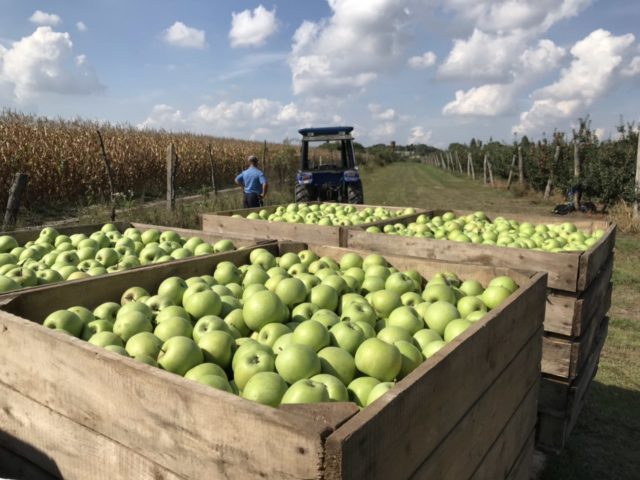
Apples tolerate transportation well
Advantages and disadvantages
The Mutsu apple tree has advantages and disadvantages.
Pros:
- low height on a dwarf rootstock, which makes tree care easier;
- good taste;
- hypoallergenicity of apples and the absence of coloring substances in their composition;
- high shelf life and the ability to transport over long distances.
Minuses:
- average frost resistance, requiring additional protection from winter cold;
- insufficiently good resistance to diseases and pests.
Planting and care
The Mutsu apple tree can be planted both in spring and autumn.
When choosing Mutsu apple tree seedlings for planting, you should pay attention to:
- Age – one- or two-year-old specimens are considered most suitable for planting. Age can be determined by the number of additional branches: a one-year-old shoot has no developed branches, and a two-year-old shoot has no more than 4 of them.
- The root system must be moist without mechanical damage or signs of disease
- The above-ground part of the shoot, which must be viable and not show signs of dryness.
- Foliage – healthy seedlings should have full foliage cover.
Fertile chernozem soils are more suitable for growing Mutsu apple trees. If there is none in the garden, you can prepare the soil yourself by adding sand and peat to clay soil, and peat and clay to sandy soil.
The area should be level, well lit and protected from cold winds.
To plant an apple tree:
- dig a hole about 80 cm deep and about 1 m in diameter;
- fill the bottom with a layer of drainage (river pebbles, broken bricks), after which they form a small hill from a mixture of compost, wood ash, fertile soil and mineral fertilizers;
- place the seedling in the center of the hole and straighten the roots;
- fill the tree so that the root collar is 4-7 cm above the soil surface;
- the soil in the root zone is compacted;
- a small earthen roller is formed around the seedling, after which two buckets of water are poured into the resulting hole;
- The soil in the root zone is mulched, this allows it to retain moisture longer.
When planting in groups, the distance between trees should be at least 3.5 m.

The hole for the seedling should be deep enough
For normal growth and further fruiting of the Mutsu apple tree, it should be provided with proper care: watering, fertilizing and pruning.
All trees are watered for the first time in the spring before buds open. After this, seedlings under 5 years old are watered 3 times a month (except for rainy seasons), and adults - during the ovary period, before harvesting and at the end of the season before wintering.
An effective and convenient way to moisten the soil for young trees is drip irrigation, in which water is supplied directly to the root system of the seedling.
The soil in the area of the tree is loosened and weeds are removed.
To get a good harvest, the Mutsu apple tree needs to be fed:
- urea - in the spring after the end of the flowering period;
- a solution of boric acid and copper sulfate - in June;
- superphosphates and calcium chloride - in the second half of August;
- manure or compost - in the second half of September.
The Mutsu apple tree needs regular pruning: in the spring, damaged and dry branches are removed, and in the fall, the crown is formed, cutting off all improperly growing shoots.
For the winter, young seedlings are covered with foamed polyethylene, bags or agro-fabric. The soil in the root zone is covered with a thick layer of mulch.
Collection and storage
Depending on the growing region, apples are harvested in September-November.
Only picked fruits are left for the winter. It is better to recycle the fallen ones.
Ideally, store apples in wooden or plastic boxes. Before laying, the fruits are sorted and then placed in prepared containers, sprinkled with sawdust or small wood shavings.
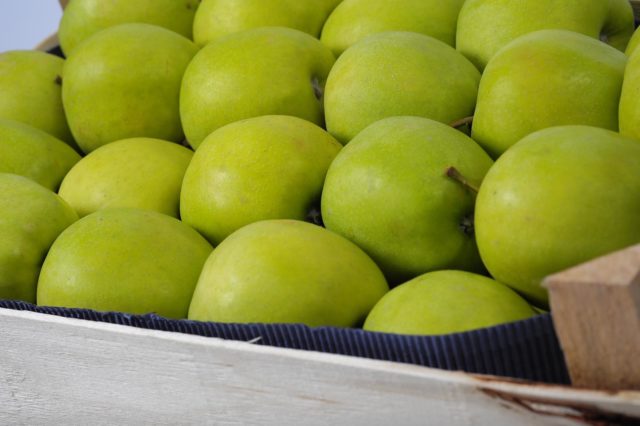
Only picked apples are suitable for storage.
Conclusion
Thanks to its good taste and long shelf life, the Mutsu apple tree variety has won the love of gardeners in different regions of the country. With a minimum of effort, you can have delicious and aromatic apples on the table all winter.
Reviews
